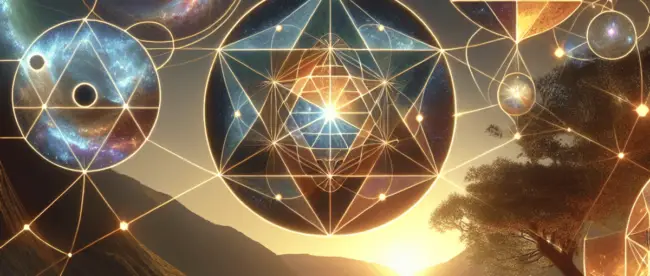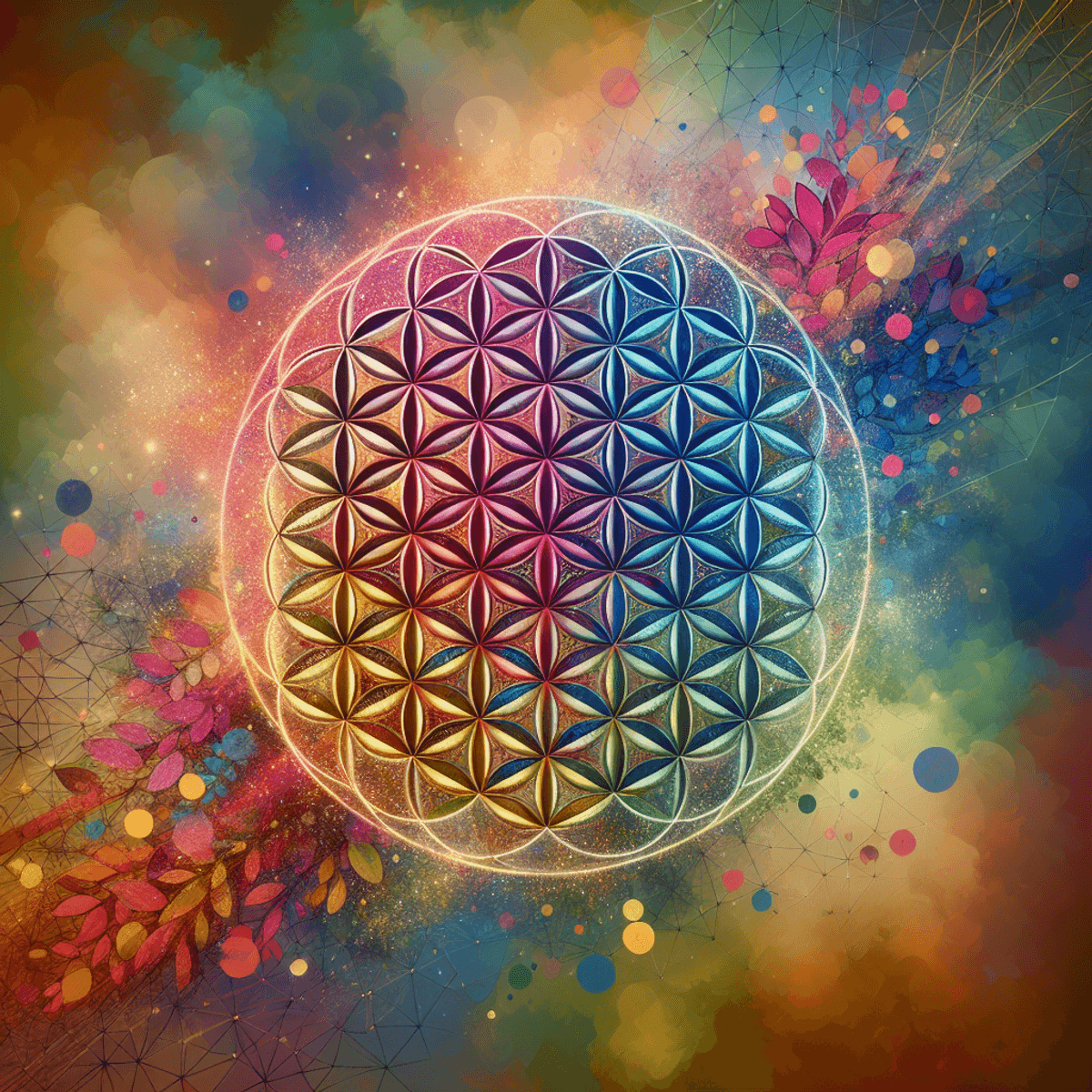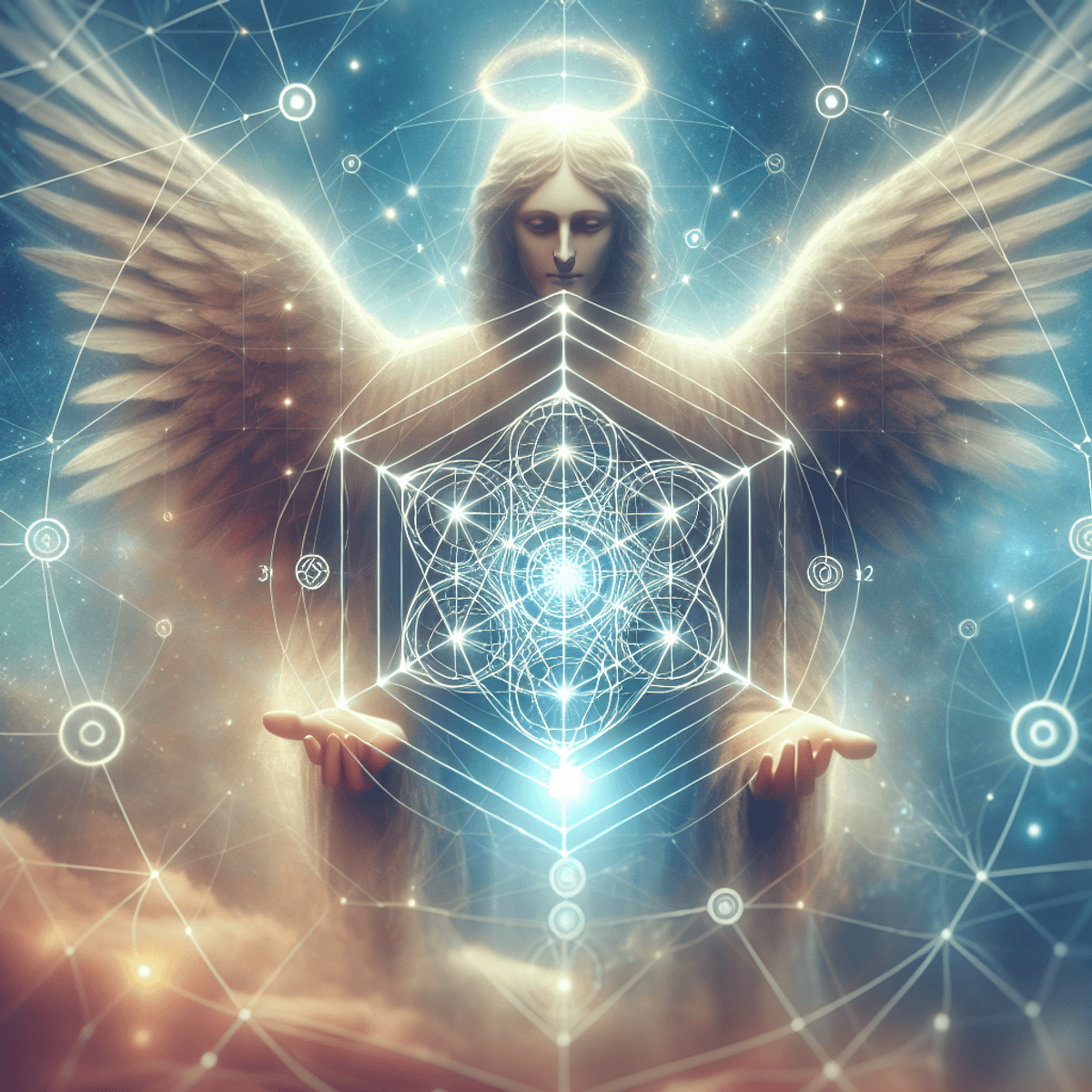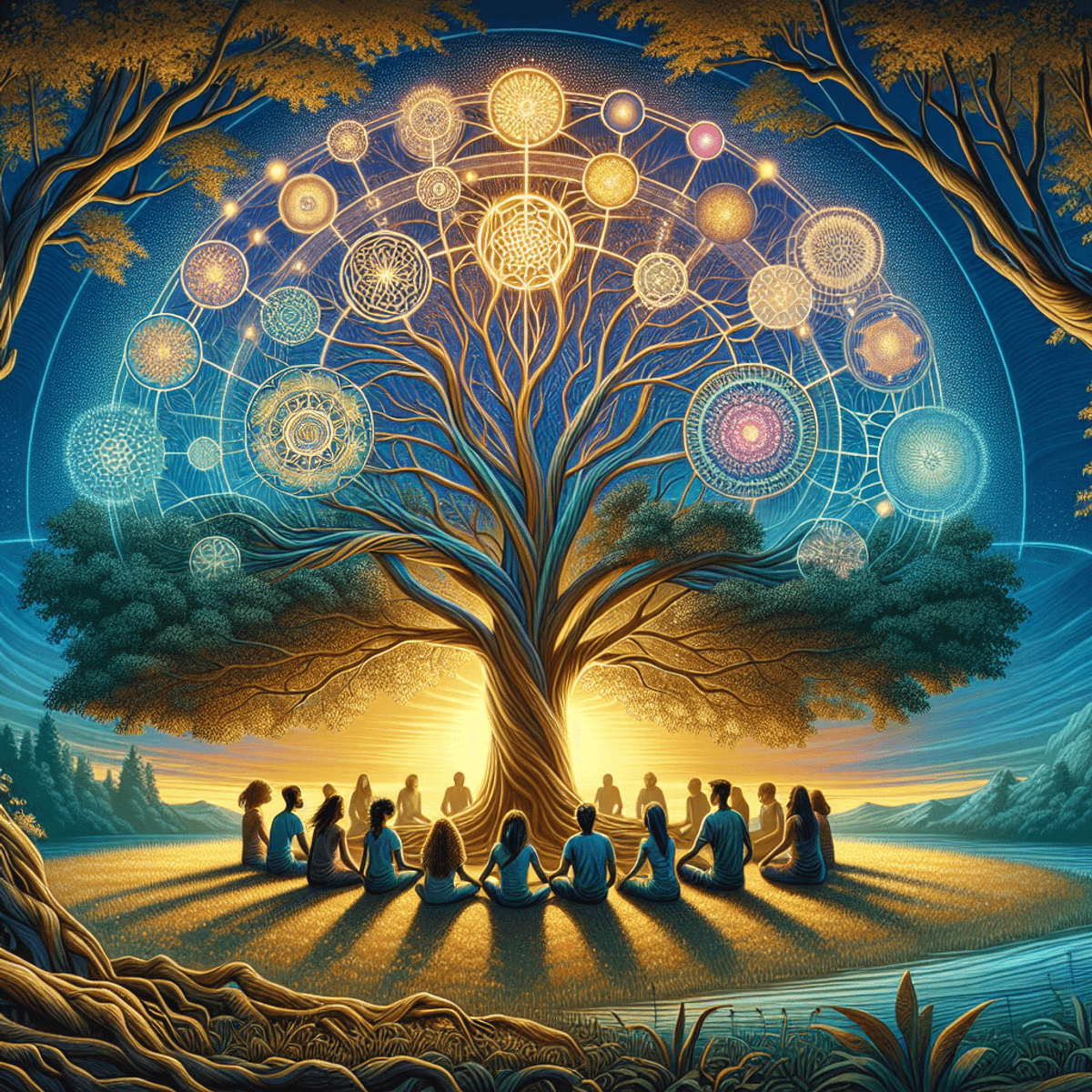Spiritual Geometry 101: Understanding the Symbols That Connect Us to the Divine

Introduction
Spiritual geometry, also known as sacred geometry, is the study of geometric shapes and patterns that have spiritual meaning. These patterns are thought to represent the basic structure of the universe, serving as a cosmic blueprint that connects physical forms to spiritual truths.
Understanding the connection between geometry and the universe can help us feel more connected to the divine. By studying these symbols, we can explore how the material world relates to higher spiritual dimensions.
The Foundations of Spiritual Geometry
Historical Context
Ancient civilizations, such as the Egyptians and Greeks, incorporated geometric principles into their spiritual practices. A prime example is the Pyramids of Giza, which demonstrate how mathematical shapes were used to align with cosmic energies and divine principles. Greek philosophers like Pythagoras regarded numbers and shapes as sacred, believing they held the keys to unraveling the mysteries of the universe.
Mathematical Shapes as Tools for Understanding Creation
Mathematical shapes serve as tools for grasping creation and existence. In various spiritual traditions, specific geometric shapes hold profound meanings:
- Circles: Represent wholeness and eternity, often symbolizing the cycle of life.
- Triangles: Denote stability and the balance between mind, body, and spirit.
- Squares: Embody order and structure, reflecting earthly foundations.
These geometric spiritual symbols offer insights into the nature of reality and our place within it.
Energy Patterns in Nature
Energy patterns found in nature also hold significant importance in spiritual geometry. The spirals of galaxies, the branching patterns of trees, and the symmetry of snowflakes all reflect underlying geometric principles. These natural formations illustrate interconnectedness—a core concept in spiritual geometry.
- Fibonacci Sequence: This mathematical series appears frequently in nature, demonstrating growth patterns in flowers and shells.
- Golden Ratio (Phi): Found in art, architecture, and nature, this ratio exemplifies aesthetic harmony and balance.
Understanding these energy patterns helps us see how everything is interconnected, reinforcing the idea that geometric shapes have a spiritual meaning.
Interconnectedness Through Geometry
Spiritual geometric shapes are not just abstract concepts; they represent real connections between physical forms and higher spiritual truths. By studying these shapes and their meanings, you can gain a deeper appreciation for the intricate web of life that binds us all together. This awareness encourages a sense of unity with the universe and fosters a more profound connection to the divine.
Key Concepts in Sacred Geometry
Sacred symbols hold profound significance in spiritual practices across the globe. The Flower of Life and Metatron’s Cube are two prominent examples.
The Flower of Life
The Flower of Life, composed of 19 interlocking circles, is seen as a blueprint for creation and unity. It appears in numerous ancient sites and is regarded as a representation of the fundamental patterns of existence.
Metatron’s Cube
Metatron’s Cube, derived from the Flower of Life, consists of 13 circles connected by lines, representing divine order and balance.
Platonic Solids
Platonic solids are essential components in sacred geometry. These five three-dimensional shapes—tetrahedron, cube, octahedron, dodecahedron, and icosahedron—each symbolize different elements and dimensions:
- Tetrahedron: Associated with fire and the spirit.
- Cube: Represents earth and stability.
- Octahedron: Symbolizes air and balance.
- Dodecahedron: Linked to the universe or ether.
- Icosahedron: Connected with water and fluidity.
These shapes are considered the building blocks of the universe, embodying perfect symmetry and harmony.
The Golden Ratio (Phi)
The Golden Ratio (Phi) is another crucial concept in sacred geometry. This irrational number (approximately 1.618) appears frequently in nature, art, and architecture. The ratio describes aesthetic harmony that resonates universally. Leonardo da Vinci famously applied this principle in his works, including “Vitruvian Man,” demonstrating how human proportions align with cosmic principles. In nature, the Golden Ratio manifests in patterns such as flower petals, shells, and galaxies, illustrating an inherent order within chaos.
Understanding these key concepts allows you to appreciate the depth and interconnectedness inherent in sacred geometry spirituality. Exploring these symbols and principles can provide insights into the hidden structures that govern our physical and spiritual worlds.
Exploring Prominent Symbols in Spiritual Geometry
1. The Flower of Life: A Blueprint for Creation
 The Flower of Life is one of the most well-known symbols in spiritual geometry. It consists of 19 interlocking circles and represents the interconnectedness of all life and the universe.
The Flower of Life is one of the most well-known symbols in spiritual geometry. It consists of 19 interlocking circles and represents the interconnectedness of all life and the universe.
Geometric Structure and Symbolism
The geometric structure of the Flower of Life is both complex and balanced. Each circle in the pattern overlaps with six other circles, forming symmetrical shapes like hexagons and equilateral triangles. This arrangement follows specific mathematical principles that have intrigued scholars and spiritual seekers.
- Circle Overlaps: The overlapping circles create a repeating pattern that can theoretically go on forever, symbolizing the infinite nature of creation.
- Hexagonal Grid: At its center, the Flower of Life contains a hexagonal grid, representing balance and harmony in various spiritual traditions.
- Vesica Piscis: The intersecting points create Vesica Piscis shapes (two overlapping circles), emphasizing duality and unity.
Historical Significance
Throughout history, the Flower of Life has been found in many cultures and civilizations, often carved into sacred spaces like temples and cathedrals. For example:
- Ancient Egypt: Found etched on the walls of the Temple of Osiris at Abydos.
- China: Incorporated into traditional Chinese designs and architecture.
- Greece: Seen in ancient Greek art and philosophy, reflecting their search for mathematical perfection.
These historical instances show its universal appeal and perceived connection to divine order.
Representation as a Fundamental Pattern
The Flower of Life is often referred to as a blueprint for creation. This idea comes from its ability to generate other geometric forms within its structure. By connecting different points within the Flower of Life, you can create:
- Metatron’s Cube: Consisting of 13 circles connected by lines, embodying all five Platonic solids.
- Seed of Life: A smaller pattern formed by seven interconnected circles found within the larger design.
- Tree of Life: A structure that can be superimposed onto the Flower of Life, linking it to Kabbalistic teachings.
Each shape derived from the Flower carries its own symbolic meaning but remains connected to this primary geometric form.
Modern Applications
Today, the Flower of Life continues to inspire various fields:
- Art and Design: Artists use this symbol in their works to convey themes of unity and harmony.
- Architecture: Architects incorporate it into building designs to create spaces that resonate with natural balance.
- Personal Growth Practices: Spiritual practitioners meditate on or visualize this symbol as a way to align themselves with universal energies.
The ongoing presence of the Flower of Life throughout history and across cultures highlights its significance as a key symbol in spiritual geometry. Its intricate design holds fundamental truths about existence and our place in the universe. Engaging with this symbol can offer insights into personal development as well as a deeper understanding of cosmic concepts.
2. Metatron’s Cube: The Divine Order in Form
 Metatron’s Cube is a profound symbol within spiritual geometry, intricately connected to the Flower of Life. This symbol consists of 13 circles and lines that connect every center point, forming a complex arrangement embodying divine order and cosmic balance. It is named after the archangel Metatron, who is believed to be a celestial scribe recording all events in heaven.
Metatron’s Cube is a profound symbol within spiritual geometry, intricately connected to the Flower of Life. This symbol consists of 13 circles and lines that connect every center point, forming a complex arrangement embodying divine order and cosmic balance. It is named after the archangel Metatron, who is believed to be a celestial scribe recording all events in heaven.
Metatron’s Cube meaning extends beyond its visual complexity. Each line and circle within the cube represents connections between different planes of existence, making it a powerful tool for understanding the structure of the universe.
Interconnectedness with Platonic Solids
Metatron’s Cube encompasses all five Platonic solids (tetrahedron, cube, octahedron, dodecahedron, icosahedron). These shapes are foundational to understanding three-dimensional space and are seen as building blocks of creation.
Symbolic Representation
This symbol is often used in meditation practices to balance energies and align spiritual pathways. Its harmonious structure serves as a visual reminder of the interconnected nature of all things.
Practical Applications
Many people use images of Metatron’s Cube in various forms such as art, jewelry, or even tattoos. These applications help individuals stay connected to their spiritual journey and maintain a sense of divine order in their daily lives.
Metatron’s Cube stands as an epitome of how sacred geometric symbols like the Flower of Life, Metatron’s Cube, and Tree of Life serve practical purposes while also delving deeply into spiritual symbolism.
3. Tree of Life: A Universal Symbol Across Cultures
 The Tree of Life is one of the most widely recognized symbols in spiritual geometry, found in various cultural and religious traditions. It represents the idea that everything is connected, the process of growth, and the journey of the soul.
The Tree of Life is one of the most widely recognized symbols in spiritual geometry, found in various cultural and religious traditions. It represents the idea that everything is connected, the process of growth, and the journey of the soul.
1. Cross-Cultural Presence
The Tree of Life can be seen across multiple civilizations:
- Ancient Egypt: Represented eternal life and divine wisdom.
- Kabbalistic Tradition: In Jewish mysticism, it is a diagram to understand the nature of God and the human soul.
- Celtic Mythology: Depicted as a tree connecting the heavens, earth, and the underworld.
2. Bridge Between Realms
The Tree of Life often serves as a symbolic bridge connecting different realms of existence—spiritual and physical.
Its roots delve deep into the earth while its branches reach towards the heavens, embodying the balance between material and spiritual planes.
3. Symbolism in Spiritual Practices
In various spiritual practices, the Tree of Life holds significant meaning:
- Represents personal growth, strength, and individuality.
- Each part of the tree—roots, trunk, branches—symbolizes aspects of spiritual development and life’s journey.
Studying the significance of the Tree of Life reveals how it intertwines with other sacred geometric symbols like Metatron’s Cube, forming a complex network that connects us to profound spiritual truths. However, it’s essential to remember that not all tools used in these practices are beneficial. For instance, while crystals are often used for their positive energy, they can sometimes bring bad energy if not chosen or used correctly.
Understanding these symbols not only enhances our spiritual practices but also emphasizes their practical uses in promoting unity and interconnectedness.
Additional Important Symbols You Should Know About
1. Vesica Piscis: The Dance Between Duality and Unity
The Vesica Piscis is a fundamental symbol in spiritual geometry, representing the intersection of two overlapping circles. This shape, often referred to as the “bladder of a fish” in Latin, serves as a powerful metaphor for the union of dualities and the creation of new realities through balance and harmony.
Vesica Piscis Meaning and Symbolism
The Vesica Piscis carries deep symbolic meaning:
- Union of Opposites: At its core, the Vesica Piscis illustrates how two seemingly opposing forces can come together to form a balanced and harmonious whole. This union can be seen as the merging of mind and spirit, masculine and feminine energies, or any other dualistic pairings.
- Creation and Birth: The shape resembles an almond or eye, symbolizing birth and creation. In various spiritual traditions, it is viewed as a womb from which all life emerges.
- Gateway to Higher Consciousness: Many believe that the Vesica Piscis opens a portal to higher levels of awareness and understanding. The intersecting space within the symbol is thought to be a point of connection between the earthly and the divine.
Historical Context
Throughout history, the Vesica Piscis has appeared in numerous cultures:
- Christian Art: Often used in Christian iconography, it serves as a frame for Jesus Christ or Virgin Mary, highlighting their divine nature.
- Sacred Sites: Found in ancient architecture such as Gothic cathedrals and temples, this symbol has been used to signify sacred spaces.
- Mathematics and Philosophy: Philosophers like Pythagoras have explored its geometric properties, associating it with profound metaphysical concepts.
Practical Applications
In contemporary spiritual practices, you can find the Vesica Piscis incorporated into various applications:
- Meditation Tools: Many use this symbol as a focal point during meditation to achieve inner balance and unity.
- Artistic Expression: Artists often incorporate it into their work to convey themes of wholeness and interconnectedness.
- Architectural Design: Modern architects sometimes use this shape to design spaces that evoke harmony and sacredness.
Understanding the significance of the Vesica Piscis enriches your appreciation of spiritual geometry. It reminds us that true balance arises from embracing duality and finding unity within opposites.
2. Seed Of Life: The Origins Of All Creation
The Seed of Life is a crucial symbol in spiritual geometry. It is often seen as the basic building block for more complex patterns like the Flower of Life. This symbol consists of seven interlocking circles, forming a rosette pattern that represents the seven days of creation. Each circle’s intersection signifies the interconnectedness and unity of all life forms.
Key Aspects
- Foundation for Complexity: The Seed of Life is seen as the starting point for more complex geometric shapes. For example, expanding this pattern leads to the formation of the Flower of Life, which further contains Metatron’s Cube and other significant symbols.
- Symbolic Meaning: The Seed of Life encapsulates the essence of creation and existence. Its geometry reflects how life emerges from a single source, emphasizing themes of unity and interconnectedness.
- Spiritual Teachings: This symbol teaches about balance and harmony within creation. It illustrates how everything in the universe is related, mirroring the principles found in nature and spirituality.
Connecting with other sacred geometric symbols such as the Vesica Piscis, which represents duality and unity, and the Merkaba, a vehicle for higher consciousness, deepens our understanding of spiritual geometry. These symbols collectively convey vital teachings about creation, balance, and consciousness expansion.
3. Merkaba: Your Vehicle For Higher Consciousness
The Merkaba symbol is a powerful geometric configuration that serves as a multidimensional light body vehicle. It is composed of two intersecting tetrahedrons, forming a three-dimensional star tetrahedron. This shape is believed to facilitate spiritual ascension journeys, allowing individuals to achieve higher states of consciousness and connect with the divine.
Meaning of Merkaba
The term “Merkaba” is derived from ancient Egyptian and Hebrew words meaning light, spirit, and body. It represents the harmonization of these elements, enabling a transformation into higher dimensions.
Function in Spiritual Practices
The Merkaba has several functions in spiritual practices:
- Acts as a vehicle for spiritual ascension.
- Supports meditative practices aimed at expanding consciousness.
- Serves as a protective energy field that balances male and female energies.
In the context of sacred geometry, the Vesica Piscis, Seed of Life, and Flower of Life are essential building blocks that lay the foundation for understanding more complex symbols like the Merkaba. Each symbol conveys critical teachings related to creation, balance, and consciousness expansion:
- Vesica Piscis: Symbolizes perfect balance through the union of opposites.
- Seed of Life: Acts as an essential building block for more complex patterns like the Flower of Life.
The Merkaba encapsulates these principles, emphasizing unity and interconnectedness while guiding individuals on their spiritual paths. By engaging with this symbol, you can unlock deeper layers of spiritual knowledge and experience profound personal growth.
Geometric Shapes with Spiritual Meaning Beyond Basics
1. Reuleaux Triangle: Embracing Diversity Within Unity
The Reuleaux triangle, a shape that may seem unfamiliar at first glance, holds profound spiritual significance. Unlike the equilateral triangle, the Reuleaux triangle is formed by the intersection of three circular arcs. This unique geometric shape symbolizes the harmonious balance between diversity and unity.
Key Characteristics:
- Symmetry and Balance: The Reuleaux triangle is characterized by its constant width, meaning that despite its unconventional shape, it maintains symmetry and balance.
- Intersection of Paths: The intersecting arcs represent the convergence of different paths or perspectives, suggesting that diverse viewpoints can coexist harmoniously.
Spiritual Significance:
- Unity in Diversity: In spiritual terms, the Reuleaux triangle teaches us about embracing multiple aspects of life while maintaining a sense of unity. It reflects the idea that diverse elements, when brought together, can form a cohesive and balanced whole.
- Non-Conformity and Uniqueness: This shape also highlights the importance of non-conformity. Just as the Reuleaux triangle doesn’t fit into conventional geometric categories, it encourages individuals to embrace their uniqueness rather than conform to societal norms.
- Navigating Life’s Challenges: The smooth curves of the Reuleaux triangle symbolize fluidity and adaptability. Spiritually, this can be interpreted as a reminder to navigate life’s challenges with grace and flexibility, finding balance amid chaos.
Applications in Spiritual Practices:
- Meditation Aid: Visualizing or meditating upon the Reuleaux triangle can help practitioners focus on achieving balance in their lives. It serves as a reminder that harmony can be found even in seemingly disparate elements.
- Symbol for Inclusivity: In spiritual communities, this symbol can be used to promote inclusivity and acceptance of diverse beliefs and practices. It underscores the idea that all paths lead to a unified spiritual truth.
Examples in Nature and Culture:
- Natural Occurrences: The principles behind the Reuleaux triangle can be observed in natural phenomena such as certain types of rotating bearings that maintain constant pressure distribution.
- Cultural Symbolism: Various cultures have used similar shapes to represent interconnectedness and balance. For instance, in Celtic art, interwoven patterns often embody unity through diversity.
The Reuleaux triangle invites you to reflect on your own journey towards balance and harmony. It encourages embracing differences while recognizing that all parts contribute to a unified whole.
2. Sri Yantra: A Powerful Tool For Manifestation Practice
Sri Yantra is one of the most revered symbols in spiritual geometry, known for its intricate design and powerful spiritual meaning. It consists of nine interlocking triangles that radiate from a central point, representing the union of divine feminine and masculine energies, creation, and cosmic balance.
Key Features of Sri Yantra:
- Nine Interlocking Triangles: These represent the cosmos and human body, encompassing both physical and spiritual realms.
- Central Point (Bindu): The focal point symbolizes the origin of creation and the universe’s ultimate unity.
- Concentric Circles: Surrounding the triangles, these illustrate layers of consciousness and dimensions of existence.
Sri Yantra serves as a powerful tool for meditation and manifestation practices. Its geometric precision helps align one’s energy with the universal flow, fostering a deep sense of harmony and spiritual awakening. Many practitioners use Sri Yantra meditation to enhance focus, clear mental obstacles, and achieve higher states of consciousness.
Practical Applications:
- Meditation: Focusing on the Sri Yantra can facilitate deep meditative states, helping you connect with higher consciousness.
- Manifestation: Visualizing goals within the Sri Yantra aids in aligning your intentions with cosmic energies, thereby enhancing manifestation processes.
- Healing: The geometric structure promotes balance and healing by harmonizing energy fields.
Exploring symbols like the Reuleaux triangle spirituality or engaging in Sri Yantra meditation reveals how these ancient patterns continue to influence modern spiritual practices. Embracing these tools opens doors to deeper understanding and personal growth, aligning you with the sacred geometry that underpins all existence.
3. Spiral Motif: Nature’s Way of Expressing Growth and Evolutionary Patterns
The spiral motif stands out as one of nature’s most remarkable and ubiquitous patterns, symbolizing growth, evolution, and the cyclical nature of life. It appears in various forms across the natural world—from the swirling galaxies in space to the delicate spirals of seashells and the unfurling fronds of ferns. This pattern embodies a universal principle found in spiritual geometry, representing life’s dynamic process and continuous transformation.
Key aspects of the spiral motif in spiritual geometry include:
- Growth and Expansion: The spiral signifies a journey that starts from a central point and progresses outward, illustrating how life evolves from a single source. This expansion reflects personal growth, spiritual awakening, and the unfolding of consciousness.
- Cyclic Nature: Spirals also represent cycles within nature, such as seasons, life cycles, and cosmic rhythms. They remind us of the perpetual flow of energy and the interconnectedness of all life forms.
- Golden Ratio (Phi): Many natural spirals follow the Golden Ratio (Phi), a fundamental aspect of sacred geometry known for its aesthetic harmony. This ratio is evident in phenomena like hurricanes, sunflower seed arrangements, and DNA structures.
Examples of spiral motifs with spiritual significance:
- Nautilus Shell: Often cited as a perfect example of logarithmic spirals in nature, the nautilus shell grows at a consistent rate while maintaining its shape. It symbolizes inner beauty and eternal harmony.
- Galactic Spirals: The structure of galaxies often follows a spiral pattern, reflecting cosmic order on a grand scale. This celestial design can inspire awe and a sense of connection to the universe.
- Kundalini Energy: In many spiritual traditions, kundalini energy is depicted as coiled like a serpent at the base of the spine. Its upward movement through energy centers (chakras) during spiritual practices signifies awakening and enlightenment.
Understanding these motifs enriches your appreciation for spiritual geometry’s profound connection to life’s inherent patterns. The spiral motif’s representation in both macrocosm and microcosm serves as a powerful reminder of our place within this intricate web of existence.
Cultural Significance And Applications In Our Lives Today
The integration of sacred geometry symbols extends beyond spiritual practices, deeply influencing various cultural spheres. These symbols permeate numerous aspects of life:
1. Architecture
Buildings like the pyramids and cathedrals incorporate geometric principles, creating structures that resonate with harmony and balance.
2. Art Forms
Artists employ sacred geometry to evoke a sense of interconnectedness and divine order. Mandalas and intricate patterns exemplify this influence.
3. Spiritual Practices
Symbols such as the Merkaba serve as tools for meditation and ascension, facilitating deeper spiritual experiences.
Sacred geometry’s impact spans historical contexts, demonstrating its enduring presence in human culture. Understanding these patterns fosters a connection between the physical and spiritual realms, enriching contemporary life through harmonious design and spiritual growth.

